weight CHEVROLET BLAZER 1996 2.G Owners Manual
[x] Cancel search | Manufacturer: CHEVROLET, Model Year: 1996, Model line: BLAZER, Model: CHEVROLET BLAZER 1996 2.GPages: 392, PDF Size: 20.35 MB
Page 88 of 392
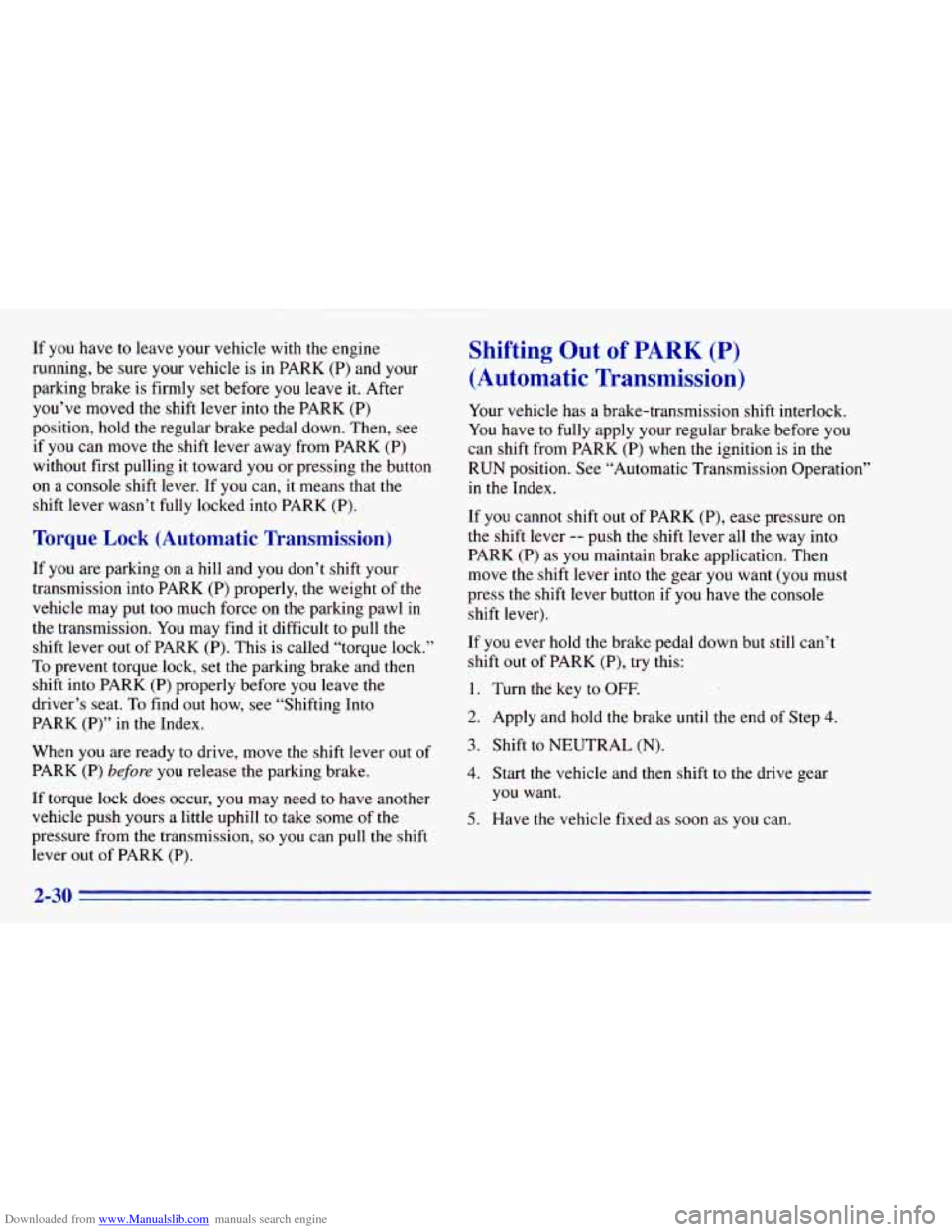
Downloaded from www.Manualslib.com manuals search engine If you have to leave your vehicle with the engine
running, be sure your vehicle is in PARK (P) and your
parking brake is firmly set before
you leave it. After
you’ve moved the shift lever into the PARK (P)
position, hold the regular brake pedal down. Then, see
if you can move
the shift lever away from PARK (P)
without first pulling it toward
you or pressing the button
on a console shift lever. If you can, it means that the
shift lever wasn’t fully locked into PARK
(P).
Torque Lock (Automatic Transmission)
If you are parking on a hill and you don’t shift your
transmission into PARK (P) properly, the weight of
the
vehicle may put too much force on the parking pawl in
the transmission. You
may find it difficult to pull the
shift lever out
of PARK (P). This is called “torque lock.”
To prevent torque lock, set the parking brake and then
shift into PARK (P) properly before you leave the
driver’s seat. To find
out how, see “Shifting Into
PARK (P)” in the Index.
When you are ready to drive, move the shift lever
out of
PARK (P) before you release the parking brake.
If torque lock does occur, you may need to have another
vehicle push yours a little uphill to take some
of the
pressure from the transmission,
so you can pull the shift
lever out of PARK
(P).
Shifting Out of PARK (P)
(Automatic Transmission)
Your vehicle has a brake-transmission shift interlock.
You have to fully apply your regular brake before you
can shift from PARK (P) when the ignition is in the
RUN position. See “Automatic Transmission Operation”
in the Index.
If
you cannot shift out of PARK (P), ease pressure on
the shift lever -- push the shift lever all the way into
PARK (P) as
you maintain brake application. Then
move the shift lever into the gear you want (you must
press the shift lever button if you have the console
shift lever).
If
you ever hold the brake pedal down but still can’t
shift out
of PARK (P), try this:
1. Turn
the key to OFF.
2. Apply and hold the brake until the end of Step 4.
3. Shift to NEUTRAL (N).
4. Start the vehicle and then shift to the drive gear
5. Have the vehicle fixed as soon as you can.
you want.
2-30
Page 115 of 392
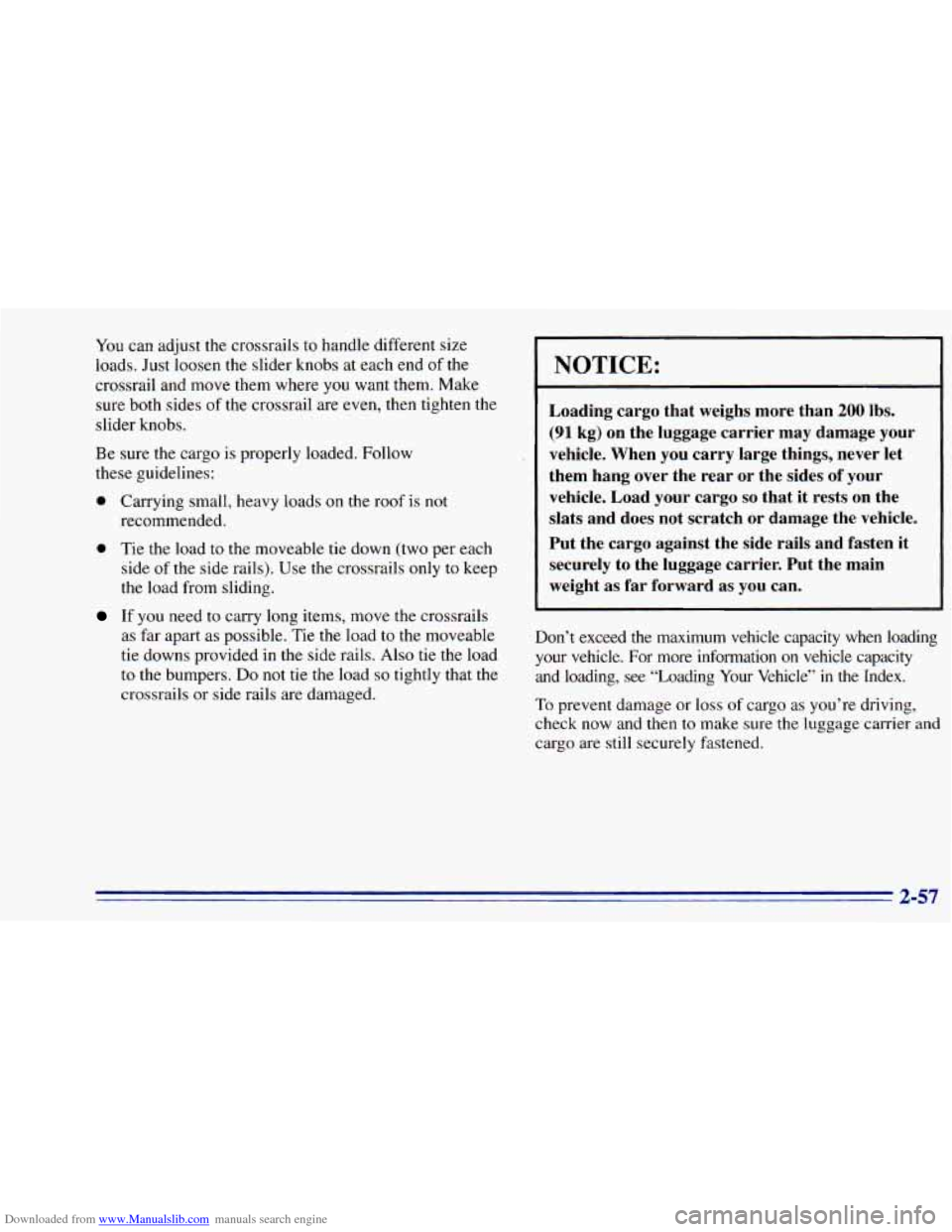
Downloaded from www.Manualslib.com manuals search engine You can adjust the crossrails to handle different size
loads. Just loosen the slider knobs at each end of the
crossrail and move them where you want them. Make
sure both sides of the crossrail are even, then tighten the
slider knobs.
Be sure the cargo is properly loaded. Follow
these guidelines:
0 Carrying small, heavy loads on the roof is not
recommended.
0 Tie the load to the moveable tie down (two per each
side
of the side rails). Use the crossrails only to keep
the load from sliding.
If you need to carry long items, move the crossrails
as far apart as possible. Tie the load
to the moveable
tie downs provided in the side rails. Also tie the load
to the bumpers.
Do not tie the load so tightly that the
crossrails or side rails are damaged.
NOTICE:
Loading cargo that weighs more than 200 lbs.
(91 kg) on the luggage carrier may damage your
vehicle. When you carry large things, never let
them hang over the rear
or the sides of your
vehicle. Load your cargo
so that it rests on the
slats and does not scratch or damage the vehicle.
Put the cargo against the side rails and fasten it
, securely to the luggage carrier. Put the main
I weight as far forward as you can.
Don’t exceed the maximum vehicle capacity when loading your vehicle. For more information on vehicle capacity
and loading, see “Loading Your Vehicle’’ in the Index.
To prevent damage or loss of cargo as you’re driving,
check now and then to make sure the luggage carrier and
cargo are still securely fastened.
2-57
Page 156 of 392
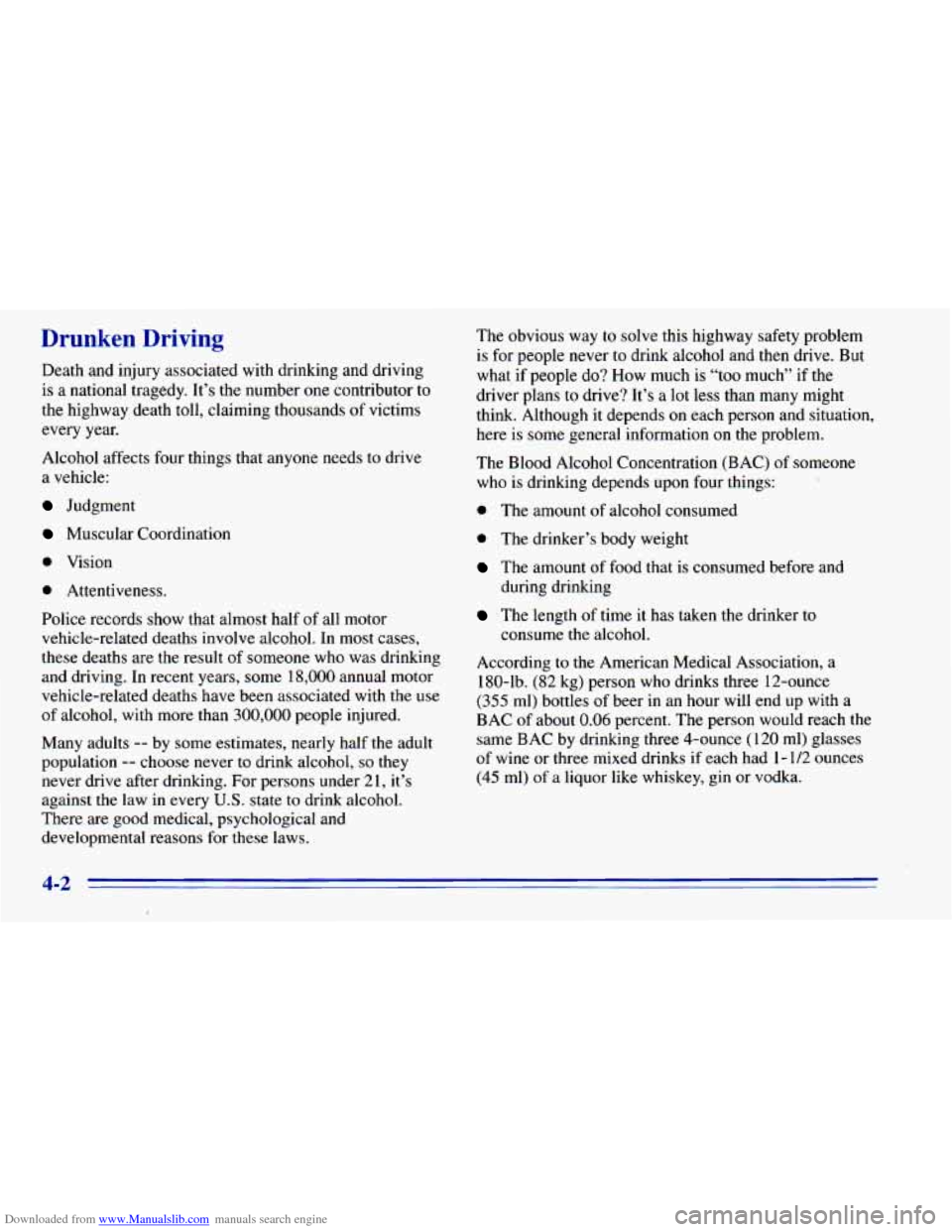
Downloaded from www.Manualslib.com manuals search engine Drunken Driving
Death and injury associated with drinking and driving
is a national tragedy. It’s the number one contributor to
the highway death toll, claiming thousands
of victims
every year.
Alcohol affects four things
that anyone needs to drive
a vehicle:
Judgment
Muscular Coordination
0 Vision
0 Attentiveness.
Police records show that almost half of all motor
vehicle-related deaths involve alcohol. In most cases,
these deaths are the result
of someone who was drinking
and driving. In recent years, some
18,000 annual motor
vehicle-related deaths have been associated with the use
of alcohol, with more than
300,000 people injured.
Many adults
-- by some estimates, nearly half the adult
population
-- choose never to drink alcohol, so they
never drive after drinking. For persons under 2 1, it’s
against
the law in every U.S. state to drink alcohol.
There are good medical, psychological and
developmental reasons for these laws. The obvious
way to solve this highway safety problem
is for people never to drink alcohol
and then drive. But
what*
if people do? How much is “too much” if the
driver plans to drive? It’s a lot less than many might
think. Although
it depends on each person and situation,
here is some general information on the problem.
The Blood Alcohol Concentration (BAC) of someone
who is drinking depends upon four things:
0 The amount of alcohol consumed
0 The drinker’s body weight
The amount of food that is consumed before and
during drinking
The length of time it has taken the drinker to
consume
the alcohol.
According to the American Medical Association, a
180-lb. (82 kg) person who drinks three 12-ounce
(355 ml) bottles of beer in an hour will end up with a
BAC of about
0.06 percent. The person would reach the
same BAC by drinking three 4-ounce (120 ml) glasses
of wine or three mixed drinks if each had 1- 1/2 ounces
(45 ml) of a liquor like whiskey, gin or vodka.
4-2
Page 157 of 392

Downloaded from www.Manualslib.com manuals search engine It’s the amount of alcohol that counts. For example, if
the same person drank three double martinis (3 ounces
or
90 ml of liquor each) within an hour, the person’s
BAC would be close to 0.12 percent. A person who
consumes food just before or during drinking will have a
somewhat lower BAC level.
There is a gender difference, too. Women generally have
a lower relative percentage of body water than men. Since
alcohol is carried in body water, this means that a
woman generally will reach
a higher BAC level than a
man of her same body weight when each has the same
number
of drinks.
The law in many
U.S. states sets the legal limit at a BAC
of
0.10 percent. In a growing number of U.S. states, and
throughout Canada, the limit is
0.08 percent. In some
other countries, it’s even lower. The BAC limit for all
commercial drivers in the United States is
0.04 percent.
The BAC will be over
0.10 percent after three to six
drinks (in
one hour). Of course, as we’ve seen, it
depends
on how much alcohol is in the drinks, and how
quickly the person drinks them.
But the ability
to drive is affected well below a BAC
of
0.10 percent. Research shows that the driving skills
of many people are impaired at a BAC approaching
0.05 percent, and that the effects are worse at night. All
drivers are impaired at BAC levels above
0.05 percent.
Statistics show that the chance of being
in a collision
increases sharply for drivers who have a BAC
of
0.05 percent or above. A driver with a BAC level of
0.06 percent has doubled his or her chance of having
a collision. At a BAC level of 0.10 percent, the chance
of this driver having a collision is
12 times greater; at a
level
of 0.15 percent, the chance is 25 times greater!
4-3
Page 179 of 392
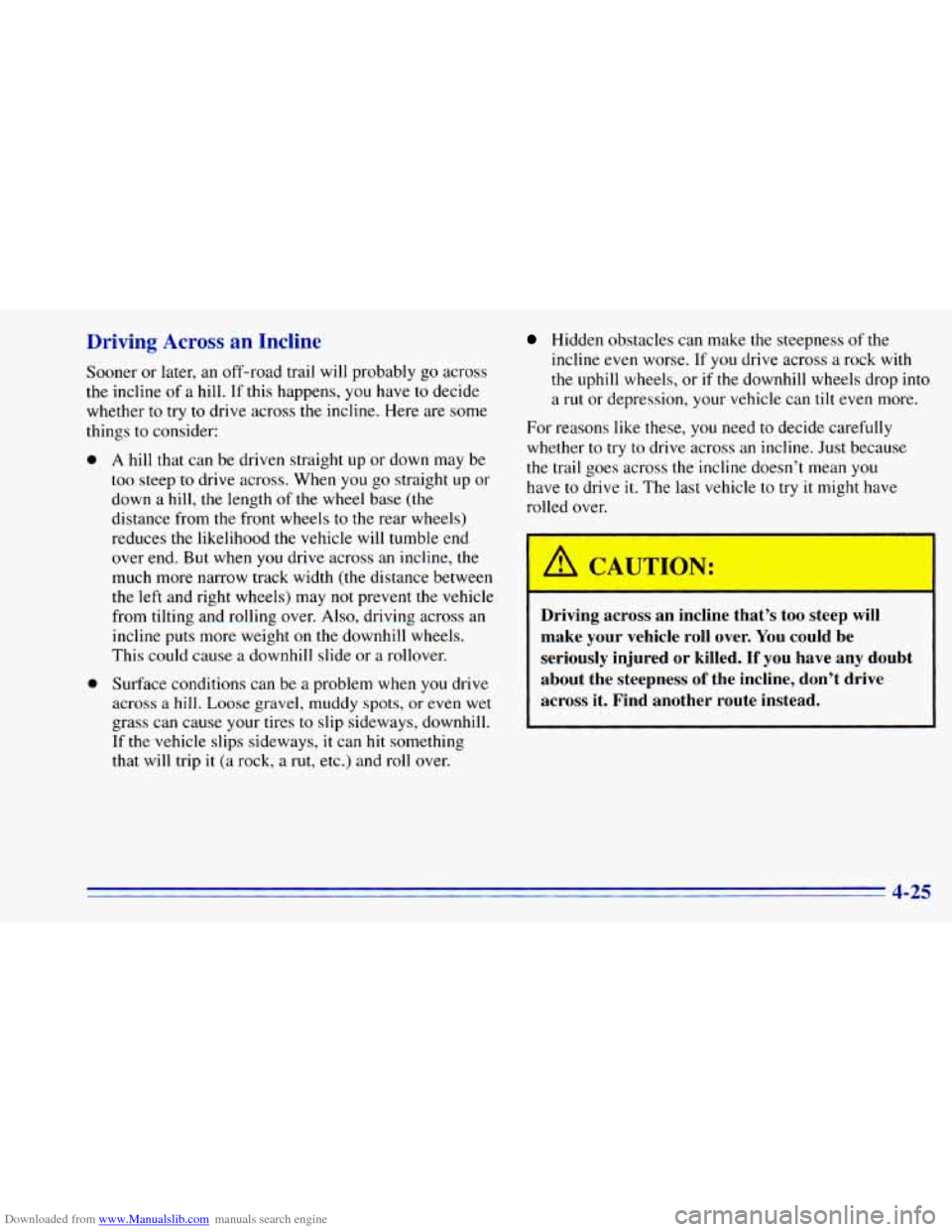
Downloaded from www.Manualslib.com manuals search engine Driving Across an Incline
Sooner or later, an off-road trail will probably go across
the incline of a
hill. If this happens, you have to decide
whether to
try to drive across the incline. Here are some
things
to consider:
0 A hill that can be driven straight up or down may be
too steep to drive across. When you go straight up or
down a hill, the length of the wheel base (the
distance from the front wheels to the rear wheels)
reduces the likelihood the vehicle will tumble end
over end.
But when you drive across an incline, the
much more narrow track width (the distance between
the
left and right wheels) may not prevent the vehicle
from tilting and rolling over. Also, driving across an
incline puts more weight on the downhill wheels.
This could cause
a downhill slide or a rollover.
0 Surface conditions can be a problem when you drive
across a
hill. Loose gravel, muddy spots, or even wet
grass can cause your tires to slip sideways, downhill.
If the vehicle slips sideways, it can hit something
that
will trip it (a rock, a rut, etc.) and roll over.
Hidden obstacles can make the steepness of the
incline even worse.
If you drive across a rock with
the uphill wheels, or if the downhill wheels drop into
a rut or depression, your vehicle can
tilt even more.
For reasons like these, you need
to decide carefully
whether to try to drive across an incline. Just because
the trail goes across the incline doesn’t mean
you
have to drive it. The last vehicle to try it might have
rolled over.
1 A CAUTION: I
Driving across an incline that’s too steep will
make your vehicle roll over. You could be
seriously injured or killed.
If you have any doubt
about the steepness
of the incline, don’t drive
across it. Find another route instead.
-1
I
4-25
Page 198 of 392
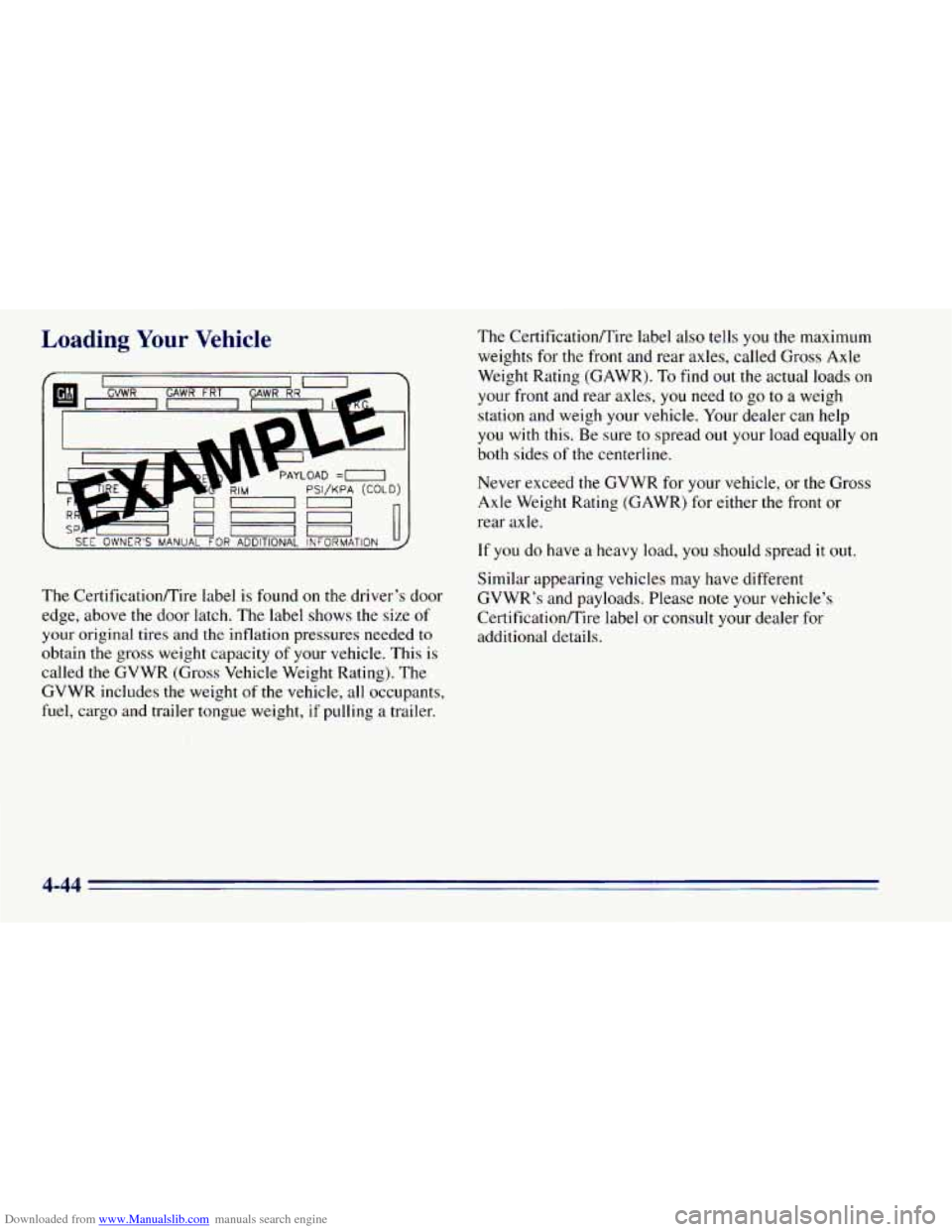
Downloaded from www.Manualslib.com manuals search engine Loading Your Vehicle
I *
‘GVWR VR F I
PAYLOAD =-I
PSI/KPA (COL
n
SEE OWNER’S MANUAL FOR ADDITIONAL INFORMATION I U
The Certificationnire label also tells you the maximum
weights for the front and rear axles, called Gross Axle
Weight Rating (GAWR). To find out the actual loads on
your front and rear axles, you need to go to a weigh
station and weigh your vehicle. Your dealer can help
you with this. Be sure to spread out your load equally on
both sides
of the centerline.
Never exceed the GVWR for your vehicle, or the Gross
Axle Weight Rating (GAWR) for either the front or
rear axle.
If you do have a heavy load, you should spread it out.
Similar appearing vehicles may have different
The Certificationrrire label is found on the driver’s door GVWR’s and payloads. \
Please note your vehicle’s
edge, above the door latch. The label shows the size of Certificationnire label or consult your dealer for
your
original tires and the inflation pressures needed to additional details.
obtain
the gross weight capacity of your vehicle. This is
called
the GVWR (Gross Vehicle Weight Rating). The
GVWR includes the weight of the vehicle, all occupants,
fuel, cargo and trailer tongue weight,
if pulling a trailer.
4-44
Page 199 of 392
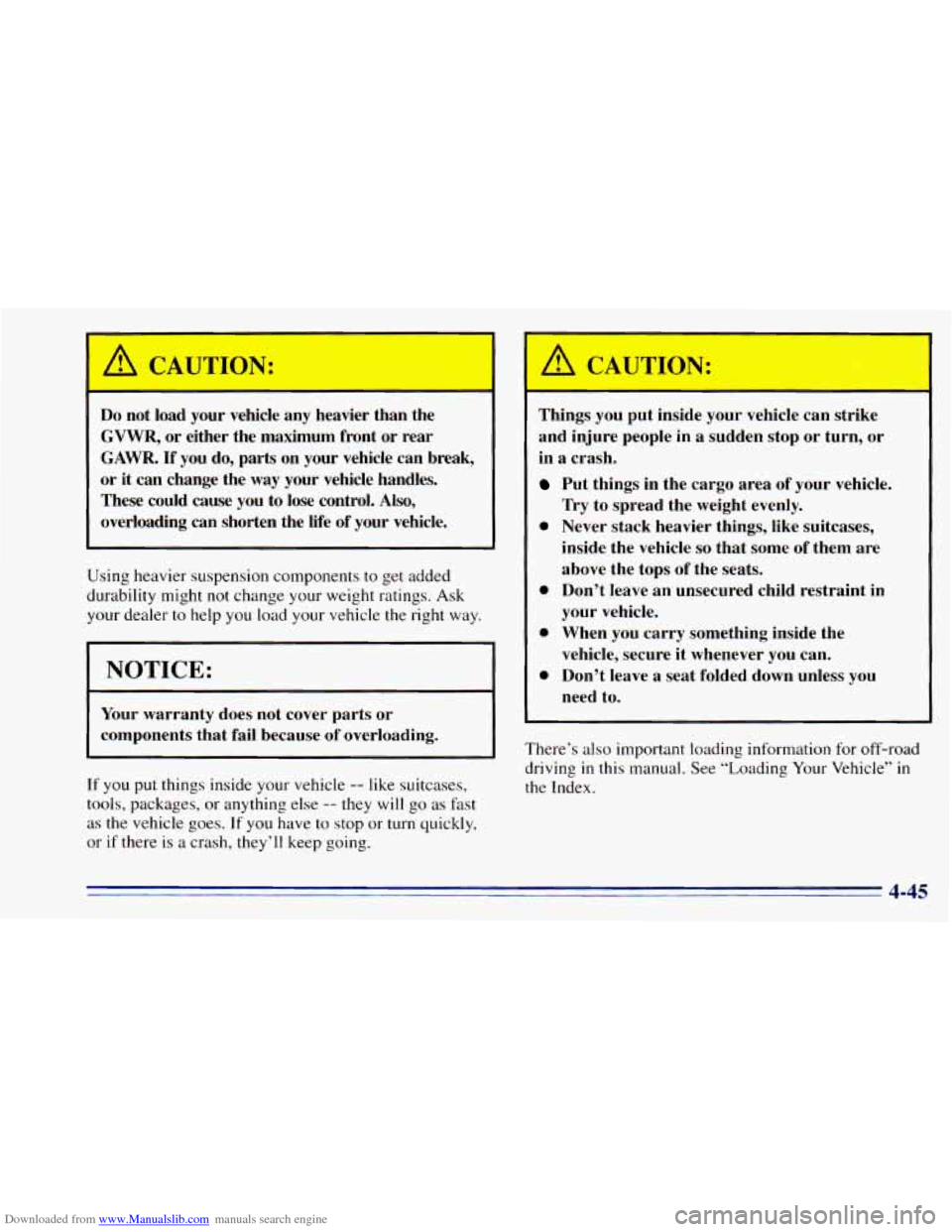
Downloaded from www.Manualslib.com manuals search engine A CAUTION:
= 1
Do not load your vehicle any heavier than the
GVWR, or either the maximum front or rear
GAWR.
If you do, parts on your vehicle can break,
or it can change the
way your vehicle handles.
These could cause you to lose control.
Also,
overloading can shorten the life of your vehicle.
Using heavier suspension components to get added
durability might not change your weight ratings. Ask
your dealer to help you load your vehicle the right way.
NOTICE:
Your warranty does not cover parts or
components that fail because of overloading.
~~
If you put things inside your vehicle -- like suitcases,
tools, packages, or anything else -- they will go as fast
as the vehicle goes. If you have to stop or turn quickly,
or if there
is a crash, they’ll keep going.
A CAUTION: ..,
Things you put inside your vehicle can strike
and injure people in
a sudden stop or turn, or
in a crash.
Put things in the cargo area of your vehicle.
0 Never stack heavier things, like suitcases,
Try to spread the weight evenly.
inside the vehicle
so that some of them are
above the tops
of the seats.
0 Don’t leave an unsecured child restraint in
your vehicle.
0 When you carry something inside the
vehicle, secure it whenever you can.
0 Don’t leave a seat folded down unless you
need to.
There’s also important loading information for off-road
driving
in this manual. See “Loading Your Vehicle” in
the Index.
4-45
Page 200 of 392
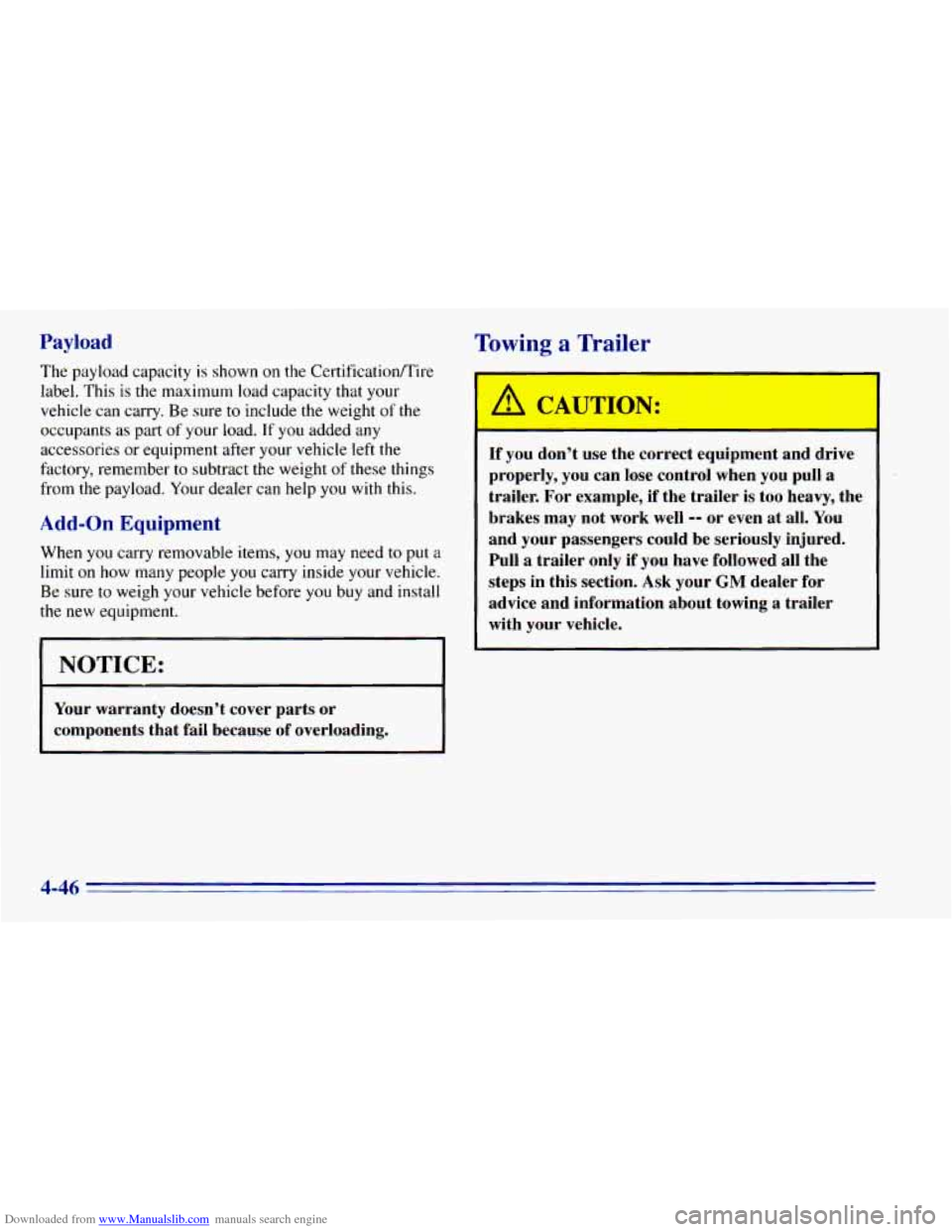
Downloaded from www.Manualslib.com manuals search engine Payload
The payload capacity is shown on the Certificationmire
label. This is the maximum load capacity that your
vehicle can carry. Be sure to include the weight of the
occupants as part
of your load. If you added any
accessories or equipment after your vehicle left the
factory, remember
to subtract the weight of these things
from the payload. Your dealer can help
you with this.
Towiy a Trailer
Add-on Equipment
When you carry removable items, you may need to put a
limit on how many people you carry inside your vehicle.
Be sure
to weigh your vehicle before you buy and install
the new equipment.
NOTICE:
Your warranty doesn’t cover parts or
components that fail because of overloading.
A CAUTION:
If you don’t use the correct equipment and drive
properly, you can lose control when you pull
a
trailer. For example, if the trailer is too heavy, the
brakes may not work well
-- or even at all. You
and your passengers could be seriously injured.
Pull
a trailer only if you have followed all the
steps in this section.
Ask your GM dealer for
advice and information about towing
a trailer
with your vehicle.
4-46
Page 202 of 392
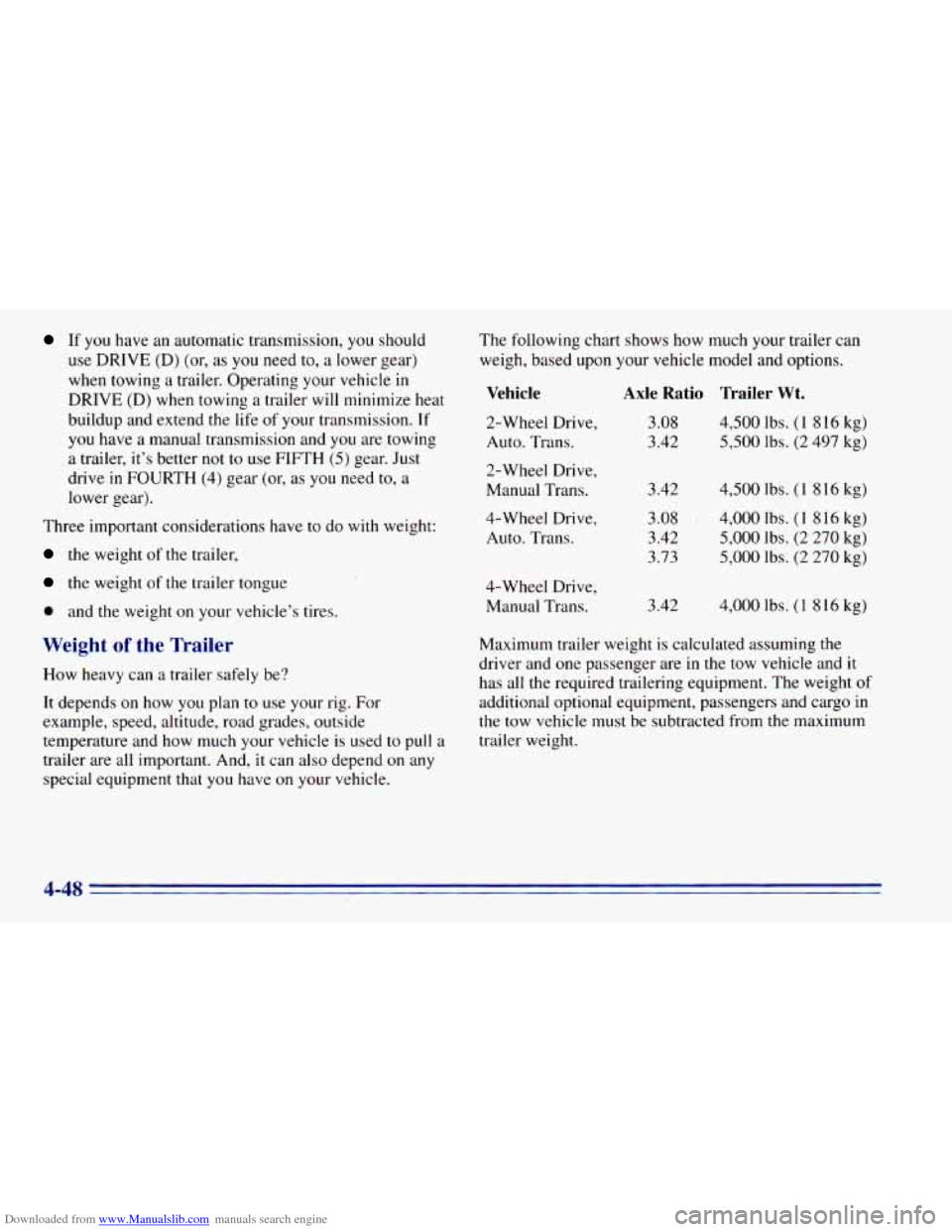
Downloaded from www.Manualslib.com manuals search engine If you have an automatic transmission, you should
use DRIVE
(D) (or, as you need to, a lower gear)
when towing a trailer. Operating your vehicle
in
DRIVE (D) when towing a trailer will minimize heat
buildup and extend the life of your transmission. If
you have a manual transmission and you are towing
a trailer, it’s better not to use FIFTH (5) gear. Just
drive in FOURTH
(4) gear (or, as you need to, a
lower gear).
Three important considerations have to do with weight:
the weight of the trailer,
the weight of the trailer tongue
0 and the weight on your vehicle’s tires.
Weight of the Trailer
How heavy can a trailer safely be?
It depends on how you plan
to use your rig. For
example, speed, altitude, road grades, outside
temperature and how much your vehicle is used
to pull a
trailer are all important. And, it can also depend on any
special equipment that you have
on your vehicle. The
following chart shows how much your trailer can
weigh, based upon your vehicle model and options.
Vehicle
2-Wheel Drive, Auto. Trans.
2-Wheel Drive,
Manual Trans.
4-Wheel Drive, Auto. Trans.
4-Wheel Drive, Manual Trans.
Axle Ratio Trailer Wt.
3.08
3.42
3.42 4,500
lbs. (1 816 kg)
5,500 lbs. (2 497 kg)
4,500 Ibs. (1 8 16 kg)
3.08
. 4,000 Ibs. (1 8 16 kg)
3.42
5,000 lbs. (2 270 kg)
3.73
5,000 lbs. (2 270 kg)
3.42
4,000 lbs. (1 8 16 kg)
Maximum trailer weight
is calculated assuming the
driver and one passenger are in the tow vehicle and it
has all the required trailering equipment. The weight
of
additional optional equipment, passengers and cargo in
the tow vehicle must be subtracted from the maximum
trailer weight.
4-48
Page 203 of 392
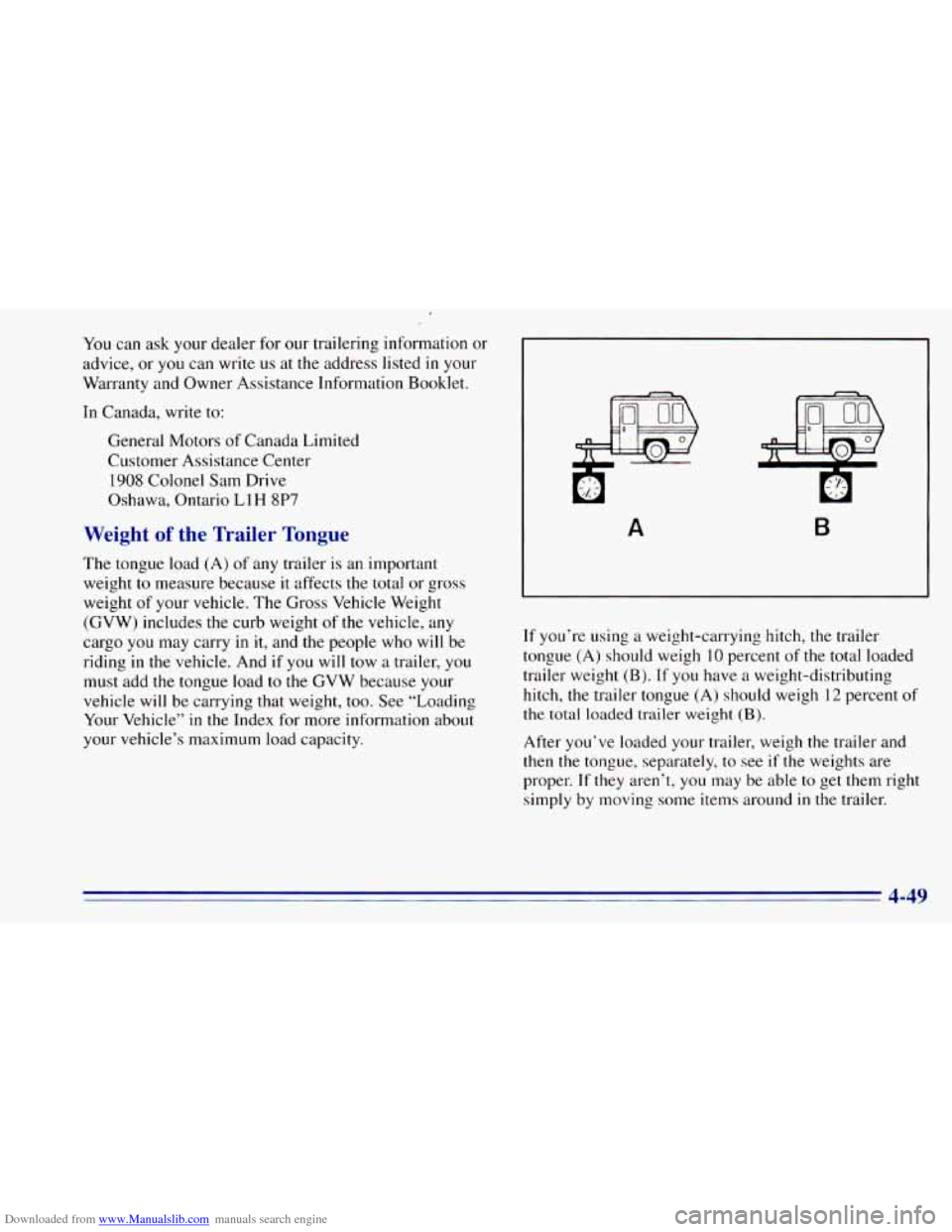
Downloaded from www.Manualslib.com manuals search engine You can ask your dealer for our trailering information or
advice, or
you can write us at the address listed in your
Warranty and Owner Assistance Information Booklet.
In Canada, write to:
General Motors of Canada Limited
Customer Assistance Center
1908 Colonel Sam Drive
Oshawa, Ontario
L 1 H 8P7
Weight of the Trailer Tongue
The tongue load (A) of any trailer is an important
weight
to measure because it affects the total or gross
weight of your vehicle. The Gross Vehicle Weight
(GVW) includes the curb weight of the vehicle, any
cargo you may carry in
it, and the people who will be
riding
in the vehicle, And if you will tow a trailer, you
must add the tongue load
to the GVW because your
vehicle will be carrying that weight, too. See “Loading
Your Vehicle”
in the Index for more information about
your vehicle’s maximum load capacity.
A B
If you’re using a weight-carrying hitch, the trailer
tongue (A) should weigh 10 percent
of the total loaded
trailer weight
(B). If you have a weight-distributing
hitch, the trailer tongue (A) should weigh 12 percent of
the total loaded trailer weight
(B).
After you’ve loaded your trailer, weigh the trailer and
then the tongue, separately, to see
if the weights are
proper.
If they aren’t, you may be able to get them right
simply by moving some items around
in the trailer.
4-49